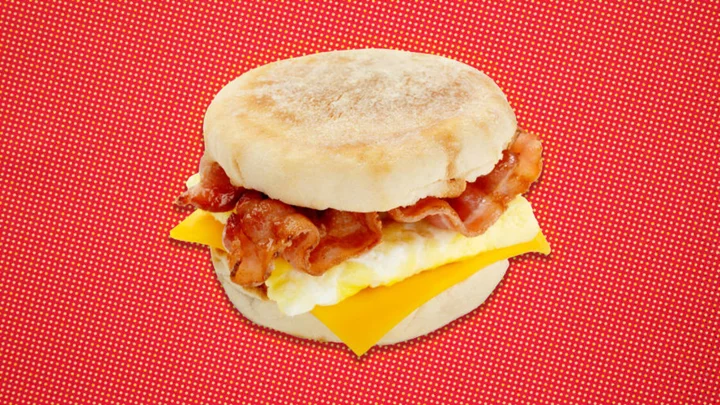People have been eating bacon, eggs, and cheese, individually or in some combination, for centuries—but the famous breakfast sandwich that’s ubiquitous in New York City and other parts of the American northeast is a surprisingly recent phenomenon.
Here’s what you need to know about the beloved breakfast dish, from the role Sigmund Freud’s nephew played in getting bacon on the breakfast table to the science that gives us perfect, plastic cheese.
Bacon, Egg, and Cheese Around the World
During the industrial revolution in London, factory workers would sometimes stop at a street vendor for a simple sandwich of eggs and sausage grease in a bap, a type of soft roll that originated in Scotland. The meal must have functioned something like a bacon, egg, and cheese does today: a quick, affordable—and portable—way to start the day, often enjoyed alongside the consumer’s caffeinated beverage of choice. Some of those egg sandwiches may have even included bacon and cheese.
Today in the UK, the preferred breakfast sandwich seems to be the bacon butty, a simple offering with bacon and butter (interestingly, despite its name, you can find partisans on the internet championing the butter-less bacon butty).
The bacon butty is usually accompanied by either “brown sauce” or ketchup. The standard British bacon, by the way, isn’t what we’re used to getting here in the states: It’s a less fatty cut of pork that comes more from the loin than the belly, closer to what we call Canadian bacon (the Brits call the stuff we eat in the States “streaky bacon”).
Though breakfast baps preceded the modern bacon, egg, and cheese, it’s not so easy to say there’s a direct line linking the two, or that the British offering was the first of its kind. There’s evidence for bread production from more than 14,000 years ago, and it seems pretty safe to assume that someone ate an egg on bread at some point before the industrial revolution, even if they didn’t think to market their creation.
Today, eggs on (or in) bread can be found in cuisines around the world, often alongside a pork product, for breakfast or throughout the day. Israel’s sabich serves the eggs hard-boiled in a pita with eggplant and other accompaniments; given its roots in the Iraqi Jewish community, it unsurprisingly omits any form of pig. In France, you’ve got the croque madame, a ham and cheese sandwich topped with an egg, often served with bechamel sauce.
And one of the first popular breakfast sandwiches in the United States may owe a debt to Chinese food. The legendary food writer James Beard posited that the Denver sandwich—which, like its omelet sibling, features eggs, ham, bell peppers, onion, and sometimes cheese—may have been the product of 19th-century Chinese rail workers trying to create some version of egg foo young. Other writers feel the “Denver” may owe a debt to Basque immigrants, who worked as miners and shepherds in the Nevada territory. They could have been inspired by piperade, a dish of onions, peppers, and tomatoes that sometimes includes ham and eggs as well.
Whatever the Denver sandwich’s provenance, it’s easy to imagine the niche a convenient meal you could hold with one hand might have filled out West, on long cattle drives or during days spent working on the transcontinental railroad.
Bring in the Bacon
So did that early American breakfast sammy lead us straight to the bacon, egg, and cheese of today? It’s tough to say. The less-specific versions of the sandwich are so generic that they’re difficult to track. In Heather Arndt Anderson’s Breakfast: A History, she points to an 1897 cookbook for the “first recipe for a true breakfast sandwich.” For what it’s worth, it calls for chopped meat, not bacon, and doesn’t include cheese.
A 1926 publication from the University of Minnesota on “Selection and Use of Bacon” includes a recipe for a bacon-egg club sandwich served on buttered toast with mayo and tomatoes. Somewhat similar—but a Google Books search for the phrase bacon, egg, and cheese specifically doesn’t turn up anything relevant until 1990, and bacon, egg, and cheese on a roll doesn’t show up until the end of that decade.
Bacon and eggs seem like prototypical breakfast fare today, but that wasn’t always the case. And that’s not because bacon is anything new. People have been curing pork belly with salt for thousands of years—the practice likely began in present-day China, according to a 1975 paper by researchers from Armour and Company’s Food Division. People have been raising domesticated pigs in that region for thousands of years. Adding salt to meat—or, more commonly today, salts, including sodium nitrite—reduces “the amount of unbound water available for microbial growth” amongst other preserving processes, according to a 2010 analysis from the United States Institute of Medicine.
Pork has been in the Americas for about as long as Europeans. Christopher Columbus brought eight pigs with him to the Caribbean in 1493, but Hernando de Soto is the explorer referred to as the “father of the American pork industry.” He brought 13 pigs from Cuba to present-day Florida in 1539. They thrived; within three years, that number had grown more than 50 times.
Soon, pork products were an essential part of colonial economies [PDF]. Meat was for eating, of course, but lard could be used to cook, processed into candles and soap, and even worked into therapeutic applications.
Doctors don’t generally recommend eating an entire pig in one sitting. By hanging cuts of meat over a smoldering fire for one to two weeks, people could preserve their pig, long before refrigeration was a viable option.
The appetite for bacon seemed especially strong in the American south. After author and New Englander Emily Burke went down to Georgia in the 1840s, she noted that “the people of the South would not think they could subsist without their [swine] flesh; bacon, instead of bread, seems to be THEIR staff of life.”
Much of that bacon, of course, would have been processed by the skilled but unpaid labor of enslaved people. For as much work as the butchery and curing of pork represented on plantations, it also created a rare opportunity to enjoy the pleasures of indulgence. As Christopher Wilson wrote for Smithsonian Magazine, a study of the Works Progress Administration’s slave narrative project reveals that “hog killing time arises over and over as a joyous memory.”
It would be a gross misrepresentation, of course, to say that pork products like bacon could unite such an unequal and divided country. But the appetite for those products, across racial lines, was certainly strong. According to Sam Bowers Hilliard’s Hog Meat and Hoecake: Food Supply in the Old South, 1840-1860, “One estimate placed the per capita consumption of pork during the period at three times that of Europe.”
As the 19th century turned to the 20th, though, bacon sales waned. Large breakfasts started to fall out of favor. As the country urbanized, fewer people felt the need (or had the time) for a hearty morning meal. Breakfast cereals started to gain popularity around that era, thanks in part to a guy who had a lot of thoughts about masturbation.
Though bacon hadn’t, by any means, been exclusively a breakfast food, these new eating habits helped put a dent in its sales. The Beech-Nut Packing Company wanted more Americans to bring home the bacon, so, in the 1920s, they enlisted the help of Edward Bernays, sometimes called the “father of public relations.”
Bernays, the nephew of Sigmund Freud, honed in on breakfast, thinking he could argue that a larger morning meal is better for health. Four out of five doctors agreed. Actually, around 4500 out of 5000; Bernays had asked a physician to write to thousands of his colleagues, and the great majority—according to Bernays, at least—co-signed on the concept of a heavy breakfast as “scientifically desirable.”
Around the same time, companies like Oscar Meyer found success in the U.S. market selling pre-sliced bacon, eventually helping to cement its place as a worthy part of a complete breakfast. With the connection of bacon and eggs established, it was only a matter of time before they’d find fame between bread.
Say Cheese
There’s not much to say about the second ingredient on our sandwich. Our ancestors were probably eating eggs before they were even Homo sapiens, with some estimates for hominid egg consumption going back millions of years—long before anyone domesticated birds. An Ancient Roman cookbook has a recipe for something like an omelet with honey. When ordering your bacon, egg, and cheese, you can typically have your eggs cooked however you like—you can specify scrambled or fried or just let your grill cook choose for you.
You can also request a specific kind of cheese, but the standard-issue sandwich definitely comes with American. Because it’s made by blending cheese with emulsifying salts (amongst other things), American cheese has the ability “to melt without breaking or turning greasy the way a traditional cheese does,” in the words of food columnist J. Kenji López-Alt. A common choice for an emulsifying salt is sodium citrate.
Despite its name, the science behind American cheese was developed by two men from Switzerland, one from Canada, and maybe one in New York, too.
In the early 1900s, Walter Gerber and Fritz Stettler used sodium citrate to repurpose excess cheese scraps and preserve Switzerland’s beloved Emmental. Shortly after (whether he was building on the Swiss process or working completely independently is a matter of some debate), Canadian-born J.L. Kraft came up with what he called “warm cheese.”
Kraft’s original process didn’t include emulsifying salts—the first U.S. patent to include that element came from the aforementioned New Yorker, George Herbert Garstin. But, as you might have guessed from Kraft’s last name, his company ultimately made the biggest mark in the quasi-cheese game.
Which raises the question: Is American cheese actually cheese?
Kind of. Kraft singles were, for a time, considered a “pasteurized process cheese food” by the FDA, which means they had to have at least 51 percent cheese content. (Kraft has since rebranded under the uncontrolled label of “pasteurized prepared cheese product,” but the cheese content likely remains the same). The FDA also says that “process cheese foods” have to be formed into a “homogeneous plastic mass.”
That doesn’t mean your Kraft singles are made from petroleum, though; the FDA is using a different meaning of the adjective plastic, like Merriam-Webster.com’s third entry for the word, “capable of being molded or modeled.”
Roll With It
At this point, we’ve discussed the history of bacon, eggs, and American cheese, but there’s one key missing ingredient from our bacon, egg, and cheese. Sure, you can get a breakfast sandwich on a bagel or brioche, but when New Yorkers complain about not being able to find their favorite breakfast item in other states, they might really be saying they can’t find the same kind of roll.
Called a “hard roll” or “kaiser roll” (the former name apparently came into fashion during World War I, thanks to anti-German sentiment), it “has an almost cracker crisp crust on the outside and [is] soft and chewy on the inside,” in the apt words of one ex-New Yorker on Reddit.
These are not bespoke artisanal creations. According to a piece by Sadie Stein in The New York Times, “Most rolls sold at delis and coffee carts come from a few large distributors.”
Large, in this case, does not mean bad. The kaiser roll actually comes from a proud lineage of high-quality industrial baking. At 1876’s Centennial Exhibition in Philadelphia, one of the attractions was Louis Fleischmann’s Vienna Model Bakery, which featured, among other award-winning offerings, consistently tasty kaiser rolls. Fleischmann soon found success with bakeries throughout the northeast. He’s also, incidentally, credited with pioneering the practice known as the bread line—his bakeries would pass out simple sustenance to residents in need.
There are a number of stories for how the kaiser roll got its name, all related to its German meaning: “emperor” in English. That could be because the design on top of the roll looks like a crown; it could be an homage to the man sometimes called the most beloved leader of the Austro-Hungarian empire, Franz Joseph I; others say it’s a nod to Holy Roman Emperor Joseph II, and supposedly has something to do with the royal deregulation of roll prices. It’s unclear which one is correct, but here’s a weird fact: Louis Fleischmann, who helped popularize kaiser rolls in the United States, actually received two medals from Kaiser Franz Joseph I for his bravery in the Austro-Prussian war. He was apparently shot off his horse twice in one battle.
The kaiser roll (with or without poppy or sesame seeds) proved popular in New York’s Jewish community and beyond. It provides a perfect textural backdrop for a bacon, egg, and cheese. It’s not too bready, but it has the heft to stand up to the other ingredients. It adds an extra level of crunch and will survive if you eat it on the street, as mother nature intended.
Enter the Egg McMuffin
There’s surprisingly little out there about how this exact combination of ingredients came to be viewed as its own defined dish and spread throughout bodegas and delis. Sometime in the second half of the 20th century, it seems to have proliferated at truck stops, diners, and food carts—places where people wanted to get something tasty and fast.
And fast food itself might have helped popularize the concept of a grab-and-go breakfast sandwich. In the early ‘70s, Jack in the Box locations had started operating 24 hours a day. They eventually came up with the Breakfast Jack—ham, fried egg, and American cheese on a hamburger bun. Around the same time, in what we can generously assume was a coincidence, a Californian McDonald’s operator decided to create a breakfast version of the eggs Benedict. It became known as the Egg McMuffin.
The bacon, egg, and cheese isn’t as conformist as a McMuffin—there are certainly no Teflon rings involved to shape a perfectly circular egg. But it’s hard to watch a grill cook prep a half dozen sandwiches in four minutes or less and say you’ve ever gotten food i your hands faster.
Sometimes, food is about luxuriating in the moment, slowing down to enjoy a hot bowl of soup in winter or a dozen cold oysters on a sunny afternoon. Other times, especially in a busy metropolis with a debatable mass-addiction to work (what other city would brag about never sleeping?), food is about the most efficient method of getting nutrients into your body.
And sometimes, when the right dish comes along, it’s about both. There’s an old expression you might hear in fields as diverse as plumbing and filmmaking: “You can have it fast, you can have it good, you can have it cheap: pick two.” But thanks to the bacon, egg, and cheese, when breakfast rolls around, as long as you’ve got a five-dollar bill and a deli within walking distance, you can pick all three.
Bacon, Egg, and Cheese As Hangover Cure
These days, whether you’re getting them from your local deli or favorite fast food spot, sandwiches like the bacon, egg, and cheese are known as being antidotes for a hangover. But does science support these common folk beliefs about the curative properties of grease?
In a word, no. But that doesn’t mean it isn’t based on a real physiological phenomenon.
By the time you wake up after a night of imbibing too much, “the alcohol has been digested and processed by your body so there is nothing to ‘absorb,’” as registered dietitian Amy Shapiro told NBC News. All the delicious carbs in the world won’t “soak up” the booze (you would have been better off not drinking to excess, but hey—nobody’s perfect).
Part of the reason you crave that fatty meal is a neuropeptide called galanin. Galanin production increases after a night of heavy drinking, so you might very well wake up with elevated levels of the brain chemical in your system. And as University of North Carolina researcher William Gruchow told Popular Science, “Galanin increases appetite for fats.” So even if the magical hangover-fixing abilities of a fatty sandwich are exaggerated, galanin could contribute to the very real craving for one after an evening of questionable decision-making.
This story was adapted from an episode of Food History on YouTube. Watch the full video and subscribe to Mental Floss for new videos every week.
This article was originally published on www.mentalfloss.com as The Delicious History of the Bacon, Egg, and Cheese Sandwich.









